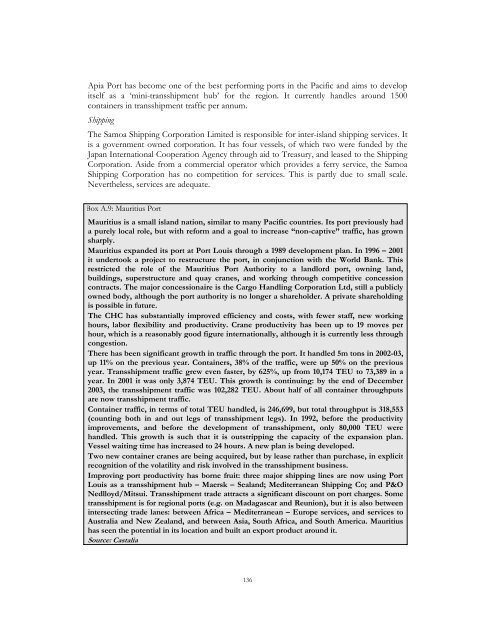EAP - The Pacific Infrastructure Challenge - World Bank (2006).pdf
EAP - The Pacific Infrastructure Challenge - World Bank (2006).pdf
EAP - The Pacific Infrastructure Challenge - World Bank (2006).pdf
Create successful ePaper yourself
Turn your PDF publications into a flip-book with our unique Google optimized e-Paper software.
Apia Port has become one of the best performing ports in the <strong>Pacific</strong> and aims to develop<br />
itself as a ‘mini-transshipment hub’ for the region. It currently handles around 1500<br />
containers in transshipment traffic per annum.<br />
Shipping<br />
<strong>The</strong> Samoa Shipping Corporation Limited is responsible for inter-island shipping services. It<br />
is a government owned corporation. It has four vessels, of which two were funded by the<br />
Japan International Cooperation Agency through aid to Treasury, and leased to the Shipping<br />
Corporation. Aside from a commercial operator which provides a ferry service, the Samoa<br />
Shipping Corporation has no competition for services. This is partly due to small scale.<br />
Nevertheless, services are adequate.<br />
Box A.9: Mauritius Port<br />
Mauritius is a small island nation, similar to many <strong>Pacific</strong> countries. Its port previously had<br />
a purely local role, but with reform and a goal to increase “non-captive” traffic, has grown<br />
sharply.<br />
Mauritius expanded its port at Port Louis through a 1989 development plan. In 1996 – 2001<br />
it undertook a project to restructure the port, in conjunction with the <strong>World</strong> <strong>Bank</strong>. This<br />
restricted the role of the Mauritius Port Authority to a landlord port, owning land,<br />
buildings, superstructure and quay cranes, and working through competitive concession<br />
contracts. <strong>The</strong> major concessionaire is the Cargo Handling Corporation Ltd, still a publicly<br />
owned body, although the port authority is no longer a shareholder. A private shareholding<br />
is possible in future.<br />
<strong>The</strong> CHC has substantially improved efficiency and costs, with fewer staff, new working<br />
hours, labor flexibility and productivity. Crane productivity has been up to 19 moves per<br />
hour, which is a reasonably good figure internationally, although it is currently less through<br />
congestion.<br />
<strong>The</strong>re has been significant growth in traffic through the port. It handled 5m tons in 2002-03,<br />
up 11% on the previous year. Containers, 38% of the traffic, were up 50% on the previous<br />
year. Transshipment traffic grew even faster, by 625%, up from 10,174 TEU to 73,389 in a<br />
year. In 2001 it was only 3,874 TEU. This growth is continuing: by the end of December<br />
2003, the transshipment traffic was 102,282 TEU. About half of all container throughputs<br />
are now transshipment traffic.<br />
Container traffic, in terms of total TEU handled, is 246,699, but total throughput is 318,553<br />
(counting both in and out legs of transshipment legs). In 1992, before the productivity<br />
improvements, and before the development of transshipment, only 80,000 TEU were<br />
handled. This growth is such that it is outstripping the capacity of the expansion plan.<br />
Vessel waiting time has increased to 24 hours. A new plan is being developed.<br />
Two new container cranes are being acquired, but by lease rather than purchase, in explicit<br />
recognition of the volatility and risk involved in the transshipment business.<br />
Improving port productivity has borne fruit: three major shipping lines are now using Port<br />
Louis as a transshipment hub – Maersk – Sealand; Mediterranean Shipping Co; and P&O<br />
Nedlloyd/Mitsui. Transshipment trade attracts a significant discount on port charges. Some<br />
transshipment is for regional ports (e.g. on Madagascar and Reunion), but it is also between<br />
intersecting trade lanes: between Africa – Mediterranean – Europe services, and services to<br />
Australia and New Zealand, and between Asia, South Africa, and South America. Mauritius<br />
has seen the potential in its location and built an export product around it.<br />
Source: Castalia<br />
136

















